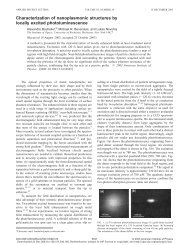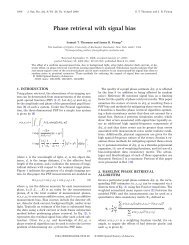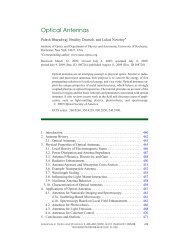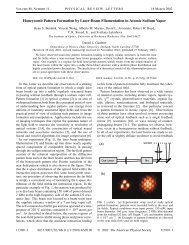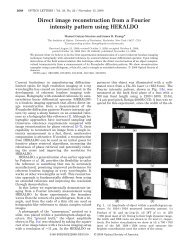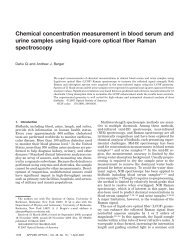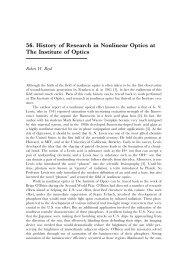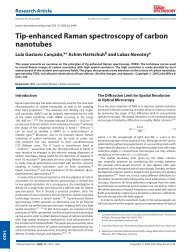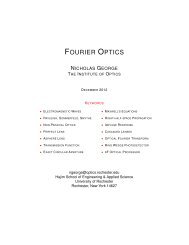Self-Phase Modulation in Optical Fiber Communications: Good or ...
Self-Phase Modulation in Optical Fiber Communications: Good or ...
Self-Phase Modulation in Optical Fiber Communications: Good or ...
You also want an ePaper? Increase the reach of your titles
YUMPU automatically turns print PDFs into web optimized ePapers that Google loves.
1/100<br />
<strong>Self</strong>-<strong>Phase</strong> <strong>Modulation</strong> <strong>in</strong> <strong>Optical</strong> <strong>Fiber</strong><br />
<strong>Communications</strong>: <strong>Good</strong> <strong>or</strong> Bad?<br />
Gov<strong>in</strong>d P. Agrawal<br />
Institute of Optics<br />
University of Rochester<br />
Rochester, NY 14627<br />
c○2007 G. P. Agrawal<br />
◭◭<br />
◮◮<br />
◭<br />
◮<br />
Back<br />
Close
Outl<strong>in</strong>e<br />
• Hist<strong>or</strong>ical Introduction<br />
• <strong>Self</strong>-<strong>Phase</strong> <strong>Modulation</strong> and its Applications<br />
• <strong>Modulation</strong> Instability and <strong>Optical</strong> Solitons<br />
• <strong>Optical</strong> Switch<strong>in</strong>g us<strong>in</strong>g <strong>Fiber</strong> Interferometers<br />
• Cross-<strong>Phase</strong> <strong>Modulation</strong> and its Applications<br />
• Impact on <strong>Optical</strong> Communication Systems<br />
• Conclud<strong>in</strong>g Remarks<br />
2/100<br />
◭◭<br />
◮◮<br />
◭<br />
◮<br />
Back<br />
Close
Hist<strong>or</strong>ical Introduction<br />
• Celebrat<strong>in</strong>g 40th anniversary of <strong>Self</strong>-<strong>Phase</strong> <strong>Modulation</strong> (SPM):<br />
F. Demart<strong>in</strong>i et al., Phys. Rev. 164, 312 (1967);<br />
F. Shimizu, PRL 19, 1097 (1967).<br />
3/100<br />
• Pulse compression though SPM was suggested by 1969:<br />
R. A. Fisher and P. L. Kelley, APL 24, 140 (1969)<br />
• First observation of optical Kerr effect <strong>in</strong>side optical fibers:<br />
R. H. Stolen and A. Ashk<strong>in</strong>, APL 22, 294 (1973).<br />
• SPM-<strong>in</strong>duced spectral broaden<strong>in</strong>g <strong>in</strong> optical fibers:<br />
R. H. Stolen and C. L<strong>in</strong> Phys. Rev. A 17, 1448 (1978).<br />
• Prediction and observation of solitons <strong>in</strong> optical fibers:<br />
A. Hasegawa and F. Tappert, APL 23, 142 (1973);<br />
Mollenauer, Stolen, and G<strong>or</strong>don, PRL 45, 1095 (1980).<br />
◭◭<br />
◮◮<br />
◭<br />
◮<br />
Back<br />
Close
<strong>Self</strong>-<strong>Phase</strong> <strong>Modulation</strong><br />
• Refractive <strong>in</strong>dex depends on optical <strong>in</strong>tensity as (Kerr effect)<br />
n(ω,I) = n 0 (ω) + n 2 I(t).<br />
4/100<br />
• Intensity dependence leads to nonl<strong>in</strong>ear phase shift<br />
φ NL (t) = (2π/λ)n 2 I(t)L.<br />
• An optical field modifies its own phase (SPM).<br />
• <strong>Phase</strong> shift varies with time f<strong>or</strong> pulses.<br />
• Each optical pulse becomes chirped.<br />
• As a pulse propagates along the fiber, its spectrum changes<br />
because of SPM.<br />
◭◭<br />
◮◮<br />
◭<br />
◮<br />
Back<br />
Close
Nonl<strong>in</strong>ear <strong>Phase</strong> Shift<br />
• Pulse propagation governed by Nonl<strong>in</strong>ear Schröd<strong>in</strong>ger Equation<br />
i ∂A<br />
∂z − β 2 ∂ 2 A<br />
2 ∂t + 2 γ|A|2 A = 0.<br />
5/100<br />
• Dispersive effects with<strong>in</strong> the fiber <strong>in</strong>cluded through β 2 .<br />
• Nonl<strong>in</strong>ear effects <strong>in</strong>cluded through γ = 2πn 2 /(λA eff ).<br />
• If we ign<strong>or</strong>e dispersive effects, solution can be written as<br />
A(L,t) = A(0,t)exp(iφ NL ), where φ NL (t) = γL|A(0,t)| 2 .<br />
• Nonl<strong>in</strong>ear phase shift depends on <strong>in</strong>put pulse shape.<br />
• Maximum <strong>Phase</strong> shift: φ max = γP 0 L = L/L NL .<br />
• Nonl<strong>in</strong>ear length: L NL = (γP 0 ) −1 .<br />
◭◭<br />
◮◮<br />
◭<br />
◮<br />
Back<br />
Close
SPM-Induced Chirp<br />
<strong>Phase</strong>, φ NL<br />
1<br />
(a)<br />
2 (b)<br />
0.8<br />
0.6<br />
0.4<br />
0.2<br />
0<br />
−2 −1 0 1 2<br />
Time, T/T 0<br />
Chirp, δωT 0<br />
1<br />
0<br />
−1<br />
−2<br />
−2 −1 0 1 2<br />
Time, T/T 0<br />
• Super-Gaussian pulses: P(t) = P 0 exp[−(t/T ) 2m ].<br />
• Gaussian pulses c<strong>or</strong>respond to the choice m = 1.<br />
• Chirp is related to the phase derivative dφ/dt.<br />
• SPM creates new frequencies and leads to spectral broaden<strong>in</strong>g.<br />
6/100<br />
◭◭<br />
◮◮<br />
◭<br />
◮<br />
Back<br />
Close
SPM-Induced Spectral Broaden<strong>in</strong>g<br />
• First observed <strong>in</strong>side fibers<br />
by Stolen and L<strong>in</strong> (1978).<br />
7/100<br />
• 90-ps pulses transmitted<br />
through a 100-m-long fiber.<br />
• Spectra are labelled us<strong>in</strong>g<br />
φ max = γP 0 L.<br />
• Number M of spectral<br />
peaks: φ max = (M − 1 2 )π.<br />
• Output spectrum depends on shape and chirp of <strong>in</strong>put pulses.<br />
• Even spectral compression can occur f<strong>or</strong> suitably chirped pulses.<br />
◭◭<br />
◮◮<br />
◭<br />
◮<br />
Back<br />
Close
SPM-Induced Spectral Narrow<strong>in</strong>g<br />
Spectral Intensity<br />
1<br />
0.8<br />
0.6<br />
0.4<br />
0.2<br />
(a)<br />
1<br />
(b)<br />
C = 0 C = 10<br />
0.8<br />
0.6<br />
0.4<br />
0.2<br />
Spectral Intensity<br />
8/100<br />
0<br />
−4 −2 0 2 4<br />
N<strong>or</strong>malized Frequency<br />
0<br />
−4 −2 0 2 4<br />
N<strong>or</strong>malized Frequency<br />
Spectral Intensity<br />
1<br />
0.8<br />
0.6<br />
0.4<br />
0.2<br />
(c)<br />
C = −10<br />
Spectral Intensity<br />
1<br />
0.8<br />
0.6<br />
0.4<br />
0.2<br />
(d)<br />
C = −20<br />
0<br />
−4 −2 0 2 4<br />
N<strong>or</strong>malized Frequency<br />
0<br />
−4 −2 0 2 4<br />
N<strong>or</strong>malized Frequency<br />
• Chirped Gaussian pulses with A(0,t) = A 0 exp[− 1 2 (1 + iC)(t/T 0) 2 ].<br />
• If C < 0 <strong>in</strong>itially, SPM produces spectral narrow<strong>in</strong>g.<br />
◭◭<br />
◮◮<br />
◭<br />
◮<br />
Back<br />
Close
SPM: <strong>Good</strong> <strong>or</strong> Bad?<br />
• SPM-<strong>in</strong>duced spectral broaden<strong>in</strong>g can degrade perf<strong>or</strong>mance of a<br />
lightwave system.<br />
• <strong>Modulation</strong> <strong>in</strong>stability often enhances system noise.<br />
9/100<br />
On the positive side . . .<br />
• <strong>Modulation</strong> <strong>in</strong>stability can be used to produce ultrash<strong>or</strong>t pulses at<br />
high repetition rates.<br />
• SPM often used f<strong>or</strong> fast optical switch<strong>in</strong>g (NOLM <strong>or</strong> MZI).<br />
• F<strong>or</strong>mation of standard and dispersion-managed optical solitons.<br />
• Useful f<strong>or</strong> all-optical regeneration of WDM channels.<br />
• Other applications (pulse compression, chirped-pulse amplification,<br />
passive mode-lock<strong>in</strong>g, etc.)<br />
◭◭<br />
◮◮<br />
◭<br />
◮<br />
Back<br />
Close
<strong>Modulation</strong> Instability<br />
Nonl<strong>in</strong>ear Schröd<strong>in</strong>ger Equation<br />
i ∂A<br />
∂z − β 2 ∂ 2 A<br />
2 ∂t + 2 γ|A|2 A = 0.<br />
10/100<br />
• CW solution unstable f<strong>or</strong> anomalous dispersion (β 2 < 0).<br />
• Useful f<strong>or</strong> produc<strong>in</strong>g ultrash<strong>or</strong>t pulse tra<strong>in</strong>s at tunable repetition<br />
rates [Tai et al., PRL 56, 135 (1986); APL 49, 236 (1986)].<br />
◭◭<br />
◮◮<br />
◭<br />
◮<br />
Back<br />
Close
<strong>Modulation</strong> Instability<br />
• A CW beam can be converted <strong>in</strong>to a pulse tra<strong>in</strong>.<br />
• Two CW beams at slightly different wavelengths can <strong>in</strong>itiate<br />
modulation <strong>in</strong>stability and allow tun<strong>in</strong>g of pulse repetition rate.<br />
11/100<br />
• Repetition rate is governed by their wavelength difference.<br />
• Repetition rates ∼100 GHz realized by 1993 us<strong>in</strong>g DFB lasers<br />
(Chernikov et al., APL 63, 293, 1993).<br />
◭◭<br />
◮◮<br />
◭<br />
◮<br />
Back<br />
Close
<strong>Optical</strong> Solitons<br />
• Comb<strong>in</strong>ation of SPM and anomalous GVD produces solitons.<br />
• Solitons preserve their shape <strong>in</strong> spite of the dispersive and<br />
nonl<strong>in</strong>ear effects occurr<strong>in</strong>g <strong>in</strong>side fibers.<br />
• Useful f<strong>or</strong> optical communications systems.<br />
12/100<br />
• Dispersive and nonl<strong>in</strong>ear effects balanced when L NL = L D .<br />
• Nonl<strong>in</strong>ear length L NL = 1/(γP 0 ); Dispersion length L D = T 2<br />
0 /|β 2|.<br />
• Two lengths become equal if peak power and width of a pulse satisfy<br />
P 0 T 2<br />
0 = |β 2|/γ.<br />
◭◭<br />
◮◮<br />
◭<br />
◮<br />
Back<br />
Close
Fundamental and Higher-Order Solitons<br />
• NLS equation: i ∂A<br />
∂z − β 2<br />
2<br />
∂ 2 A<br />
∂t 2 + γ|A| 2 A = 0.<br />
• Solution depends on a s<strong>in</strong>gle parameter: N 2 = γP 0T 2 0<br />
|β 2 |<br />
.<br />
• Fundamental (N = 1) solitons preserve shape:<br />
13/100<br />
A(z,t) = √ P 0 sech(t/T 0 )exp(iz/2L D ).<br />
• Higher-<strong>or</strong>der solitons evolve <strong>in</strong> a periodic fashion.<br />
◭◭<br />
◮◮<br />
◭<br />
◮<br />
Back<br />
Close
<strong>Optical</strong> Switch<strong>in</strong>g<br />
14/100<br />
• A Mach-Zehnder <strong>in</strong>terferometer (MZI) made us<strong>in</strong>g two 3-dB<br />
couplers exhibits SPM-<strong>in</strong>duced optical switch<strong>in</strong>g.<br />
• In each arm, optical field accumulates l<strong>in</strong>ear and nonl<strong>in</strong>ear<br />
phase shifts.<br />
• Transmission through the bar p<strong>or</strong>t of MZI:<br />
T = s<strong>in</strong> 2 (φ L + φ NL ); φ NL = (γP 0 /4)(L 1 − L 2 ).<br />
• T changes with <strong>in</strong>put power P 0 <strong>in</strong> a nonl<strong>in</strong>ear fashion.<br />
◭◭<br />
◮◮<br />
◭<br />
◮<br />
Back<br />
Close
<strong>Optical</strong> Switch<strong>in</strong>g (cont<strong>in</strong>ued)<br />
15/100<br />
• Experimental demonstration around 1990 by several groups<br />
(Nayar et al., Opt. Lett. 16, 408, 1991).<br />
• Switch<strong>in</strong>g requires long fibers and high peak powers.<br />
• Required power is reduced f<strong>or</strong> highly nonl<strong>in</strong>ear fibers (large γ).<br />
◭◭<br />
◮◮<br />
◭<br />
◮<br />
Back<br />
Close
Nonl<strong>in</strong>ear <strong>Optical</strong>-Loop Mirr<strong>or</strong><br />
16/100<br />
• An example of the Sagnac <strong>in</strong>terferometer.<br />
• Transmission through the fiber loop:<br />
T = 1 − 4 f (1 − f )cos 2 [( f − 1 2 )γP 0L].<br />
• f = fraction of power <strong>in</strong> the CCW direction.<br />
• T = 0 f<strong>or</strong> a 3-dB coupler (loop acts as a perfect mirr<strong>or</strong>)<br />
• Power-dependent transmission f<strong>or</strong> f ≠ 0.5.<br />
◭◭<br />
◮◮<br />
◭<br />
◮<br />
Back<br />
Close
NOLM Switch<strong>in</strong>g (cont<strong>in</strong>ued)<br />
17/100<br />
• Experimental demonstration us<strong>in</strong>g ultrash<strong>or</strong>t optical pulses<br />
(Islam et al., Opt. Lett. 16, 811, 1989).<br />
• T 0 = 0.3 ps, E 0 = 33 pJ, f = 0.52, 100-m loop.<br />
◭◭<br />
◮◮<br />
◭<br />
◮<br />
Back<br />
Close
Cross-<strong>Phase</strong> <strong>Modulation</strong><br />
• Consider two optical fields propagat<strong>in</strong>g simultaneously.<br />
• Nonl<strong>in</strong>ear refractive <strong>in</strong>dex seen by one wave depends on the<br />
<strong>in</strong>tensity of the other wave as<br />
18/100<br />
∆n NL = n 2 (|A 1 | 2 + b|A 2 | 2 ).<br />
• Total nonl<strong>in</strong>ear phase shift <strong>in</strong> a fiber of length L:<br />
φ NL = (2πL/λ)n 2 [I 1 (t) + bI 2 (t)].<br />
• An optical beam modifies not only its own phase but also of other<br />
copropagat<strong>in</strong>g beams (XPM).<br />
• XPM <strong>in</strong>duces nonl<strong>in</strong>ear coupl<strong>in</strong>g among overlapp<strong>in</strong>g optical pulses.<br />
◭◭<br />
◮◮<br />
◭<br />
◮<br />
Back<br />
Close
XPM-Induced Chirp<br />
• <strong>Fiber</strong> dispersion affects the XPM considerably.<br />
• Pulses belong<strong>in</strong>g to different WDM channels travel at<br />
different speeds.<br />
19/100<br />
• XPM occurs only when pulses overlap.<br />
• Asymmetric XPM-<strong>in</strong>duced chirp and spectral broaden<strong>in</strong>g.<br />
◭◭<br />
◮◮<br />
◭<br />
◮<br />
Back<br />
Close
XPM: <strong>Good</strong> <strong>or</strong> Bad?<br />
• XPM leads to <strong>in</strong>terchannel crosstalk <strong>in</strong> WDM systems.<br />
• It can produce amplitude and tim<strong>in</strong>g jitter.<br />
20/100<br />
On the other hand ...<br />
XPM can be used beneficially f<strong>or</strong><br />
• Nonl<strong>in</strong>ear Pulse Compression<br />
• Passive mode lock<strong>in</strong>g<br />
• Ultrafast optical switch<strong>in</strong>g<br />
• Demultiplex<strong>in</strong>g of OTDM channels<br />
• Wavelength conversion of WDM channels<br />
◭◭<br />
◮◮<br />
◭<br />
◮<br />
Back<br />
Close
XPM-Induced Crosstalk<br />
21/100<br />
• A CW probe propagated with 10-Gb/s pump channel.<br />
• Probe phase modulated through XPM.<br />
• Dispersion converts phase modulation <strong>in</strong>to amplitude modulation.<br />
• Probe power after 130 (middle) and 320 km (top) exhibits large<br />
fluctuations (Hui et al., JLT, 1999).<br />
◭◭<br />
◮◮<br />
◭<br />
◮<br />
Back<br />
Close
XPM-Induced Mode Lock<strong>in</strong>g<br />
22/100<br />
• Different nonl<strong>in</strong>ear phase shifts f<strong>or</strong> the two polarization components:<br />
nonl<strong>in</strong>ear polarization rotation.<br />
φ x − φ y = (2πL/λ)n 2 [(I x + bI y ) − (I y + bI x )].<br />
• Pulse center and w<strong>in</strong>gs develop different polarizations.<br />
• Polariz<strong>in</strong>g isolat<strong>or</strong> clips the w<strong>in</strong>gs and sh<strong>or</strong>tens the pulse.<br />
• Can produce ∼100 fs pulses.<br />
◭◭<br />
◮◮<br />
◭<br />
◮<br />
Back<br />
Close
XPM-Induced Switch<strong>in</strong>g<br />
23/100<br />
• A Mach–Zehnder <strong>or</strong> Sagnac <strong>in</strong>terferometer can be used.<br />
• Output switched to a different p<strong>or</strong>t us<strong>in</strong>g a control signal that shifts<br />
the phase through XPM.<br />
• If control signal is <strong>in</strong> the f<strong>or</strong>m of a pulse tra<strong>in</strong>, a CW signal can be<br />
converted <strong>in</strong>to a pulse tra<strong>in</strong>.<br />
• Ultrafast switch<strong>in</strong>g time (
SPM-Based 2R <strong>Optical</strong> Regenerat<strong>or</strong><br />
24/100<br />
Rochette et al., IEEE J. Sel. Top. Quantum Electron. 12, 736 (2006).<br />
• SPM <strong>in</strong>side a highly nonl<strong>in</strong>ear fiber broadens channel spectrum.<br />
• <strong>Optical</strong> filter selects a dom<strong>in</strong>ant spectral peak.<br />
• Noise <strong>in</strong> “0 bit” slots is removed by the filter.<br />
• Noise <strong>in</strong> “1 bit” slots is reduced considerably because of<br />
a step-like transfer function.<br />
◭◭<br />
◮◮<br />
◭<br />
◮<br />
Back<br />
Close
XPM-Based Wavelength Converter<br />
25/100<br />
Wang et al., IEEE J. Lightwave Technol. 23, 1105 (2005).<br />
• WDM channel at λ 2 requir<strong>in</strong>g conversion acts as a pump.<br />
• A CW probe is launched at the desired wavelength λ 1 .<br />
• Probe spectrum broadens because of pump-<strong>in</strong>duced XPM.<br />
• An optical filter blocks pump and transfers data to probe.<br />
• Raman amplification improves the device perf<strong>or</strong>mance.<br />
◭◭<br />
◮◮<br />
◭<br />
◮<br />
Back<br />
Close
XPM-Induced Demultiplex<strong>in</strong>g<br />
26/100<br />
• XPM can be used to demultiplex <strong>Optical</strong> TDM channels.<br />
• Control Clock is a pulse tra<strong>in</strong> at s<strong>in</strong>gle-channel bit rate.<br />
• Only pulses overlapp<strong>in</strong>g with the clock pulses are transmitted by<br />
the nonl<strong>in</strong>ear optical loop mirr<strong>or</strong>.<br />
◭◭<br />
◮◮<br />
◭<br />
◮<br />
Back<br />
Close
XPM-Induced Demultiplex<strong>in</strong>g<br />
27/100<br />
Olsson and Blumenthal, IEEE Photon. Technol. Lett. 13, 875 (2001).<br />
• Use of a Sagnac <strong>in</strong>terferometer is not necessary.<br />
• Configuration similar to the wavelength-conversion scheme.<br />
• A pulse tra<strong>in</strong> at the s<strong>in</strong>gle-channel bit rate acts as the pump.<br />
• Only pulses overlapp<strong>in</strong>g with the pump pulses experience XPM and<br />
are transmitted by the optical filter.<br />
◭◭<br />
◮◮<br />
◭<br />
◮<br />
Back<br />
Close
Conclud<strong>in</strong>g Remarks<br />
• SPM and XPM are feared by telecom system designers because they<br />
can affect system perf<strong>or</strong>mance adversely.<br />
28/100<br />
• <strong>Fiber</strong> nonl<strong>in</strong>earities can be managed th<strong>or</strong>ough proper system design.<br />
• SPM and XPM are useful f<strong>or</strong> many device and system applications:<br />
optical switch<strong>in</strong>g, soliton f<strong>or</strong>mation, wavelength conversion,<br />
all-optical regeneration, demultiplex<strong>in</strong>g, etc.<br />
• Photonic crystal and other microstructured fibers have been developed<br />
f<strong>or</strong> enhanc<strong>in</strong>g the nonl<strong>in</strong>ear effects.<br />
• Non-silica fibers (chalcogenides, Bismuth oxide, etc.) are also useful<br />
f<strong>or</strong> enhanc<strong>in</strong>g the nonl<strong>in</strong>ear effects.<br />
• SPM and XPM effects <strong>in</strong> such highly nonl<strong>in</strong>ear fibers are likely to<br />
f<strong>in</strong>d new applications.<br />
◭◭<br />
◮◮<br />
◭<br />
◮<br />
Back<br />
Close



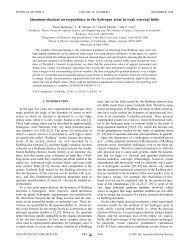
![Phase retrieval algorithms: a personal tour [Invited] - The Institute of ...](https://img.yumpu.com/25023725/1/190x249/phase-retrieval-algorithms-a-personal-tour-invited-the-institute-of-.jpg?quality=85)
